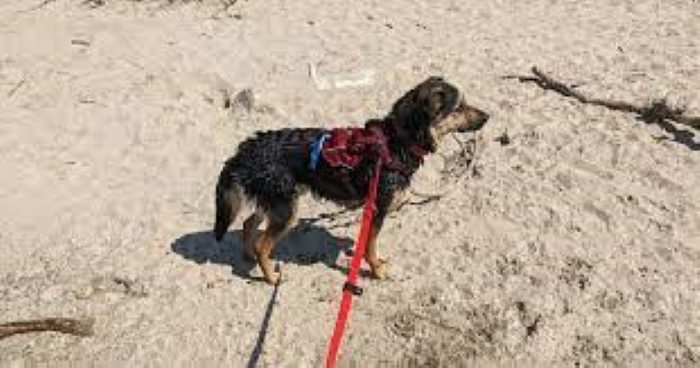Taking a dog to the beach soon and wondering if you’re prepared?
In this dog beach guide we break down everything you need to know to have a fun and safe time during your next beach adventure.
Here’s what we will cover:
- What to know about the beach before you go
- What to pack (dog checklist included)
- What to do during
- What to do after
Let’s send it!
Table of Contents
What to know before taking your dog to the beach
To have a safe and stress-free day with your dog at the beach, it’s important to do some due diligence before hitting the shores.
Here are a few things to consider before leaving for the beach with your dog.
Will your dog like the beach?
Like humans, not all dogs are fans of the sand, water, and overall beach environment.
If you’re taking a dog to the beach for the first time or it has been a while, do a test run at a local lake or beach-like environment.
The main objective of a dog beach day test run is to:
- Get your dog familiar with a beach environment
- Figure out any challenges that are specific to your dog at the beach
- Find solutions to those challenges and make adjustments before your beach trip
Did your dog have issues walking around in the hot sand during the test run? Pick up dog booties to keep those paws safe during the next hot beach day.
Doing a beach test run with your dog is optional, but recommended if you don’t know how your dog will react to the beach and you don’t go often.
Is your dog allowed at the beach?
Not all beaches are the same, especially when going to the ocean. Make sure your final beach destination is a dog-friendly beach and that you follow the dog-specific rules put in place.
A few common rules at public dog beaches are leash requirements and special hours for dogs. Some beaches have relaxed dog rules, while others are strict and have beach patrol on standby, ready to give you a ticket.
Give yourself peace of mind and avoid a ticket with a quick Google search.
Will your dog do well around other dogs?
How does your dog do around other dogs and people when not on a leash? This is important to know since many dog beaches allow dogs to run around without a leash.
Finding a dog-friendly beach that requires leashes may be a better option if your dog doesn’t do the best around others.
Will your dog listen to your commands?
It’s important to have a good understanding of your dog’s reception to commands before going to any beach. There are dangers for a dog at the beach, especially if your dog has a likelihood of chasing things and not listening to commands.
If this sounds like your dog, using a leash at all times is recommended. The last thing you want is your dog chasing something down the beach and getting lost.
What to bring with your dog to the beach
If you’re an avid beachgoer like everyone at Suh Dog, you probably know you can have a great time at the beach, even if you just showed up to the shoreline. But it doesn’t hurt to be prepared if you don’t go often, especially when bringing a dog along.
The doggy beach day checklist:
- Long dog leash
- A long dog leash works great if you plan on hanging out at the beach for a while and have enough space for your dog to wander around.
- Short dog leash
- Short dog leashes are great for walks on the beach and exploring nearby.
- If your dog is aggressive in nature, a short dog leash will likely be needed.
- Beach shade
- If it’s a hot and sunny day, bringing shade can be a lifesaver for you and your dog when laying out in the sun.
- E-Z UP
- Beach umbrella
- Beach tent
- If it’s a hot and sunny day, bringing shade can be a lifesaver for you and your dog when laying out in the sun.
- Beach towels
- Large beach towels or blankets to lay down on the sand so you can hang out without getting sand in your pants
- Personal beach towels to dry you and your dog off after getting wet
- Bring extra towels to use as needed
- Dog bed or blanket
- Bringing a lightweight dog bed or blanket can give your dog comfort in a new place
- Dog sunscreen
- If your dog’s skin is sensitive to the sun and prone to sunburns, bring canine sunscreen.
- Don’t forget the human sunscreen either!
- If your dog’s skin is sensitive to the sun and prone to sunburns, bring canine sunscreen.
- Dog life vest
- If you plan on going on a boat or exploring deeper waters with your dog, a dog lifevest can literally be a lifesaver.
- Dog lifevests are also great for dog water activities like surfing.
- If you plan on going on a boat or exploring deeper waters with your dog, a dog lifevest can literally be a lifesaver.
- Dog waterproof booties
- Keep your dog’s paws safe in hot, cold, and hazardous beach environments.
- Dog goggles
- If your dog has sensitive eyes to the sun, packing a pair of sweet dog goggles is a must.
- Dog goggles are also great for keeping sand and debris out of their eyes when zooming up and down the beach.
- Here’s a company that makes rad dog shades
- Dog first aid kit
- Take precautionary safety steps and pack a first aid kit for you and your dog.
- If you don’t want to bring it along with you to the beach, leave it in the car or somewhere easily accessible in case of an emergency.
- Take precautionary safety steps and pack a first aid kit for you and your dog.
- GPS dog tracker
- Keep your dog safe from getting lost with a waterproof GPS dog tracker.
- Even if you’re confident your dog will never run away, strong currents and populated beaches make it easy for anyone to get lost.
- Dog poop bags
- Don’t be the dog owner that never picks up their dog’s poop, especially when at a beautiful place like the beach.
- Don’t be the guy that leaves the dog poop bags everywhere either!
- Don’t be the dog owner that never picks up their dog’s poop, especially when at a beautiful place like the beach.
How to keep your dog safe at the beach
The ultimate goal is to have a fantastic day at the beach with your dog, but safety always comes first. Check out these tips and tricks to ensure your dog’s safety at the beach, allowing you to fully enjoy your time!
Find a good spot for the day
Selecting a good spot on the beach is essential if you plan to stay all day.
Here are a few things to look for when searching for a good spot for the day:
- Easy access to bathrooms and showers
- This is not a deal breaker but recommended if you have a big group or will need access to a bathroom during your stay.
- Easy access for unloading and loading your stuff if you have a ton of stuff
- If you’re going to a popular beach, try arriving early or not during peak hours to secure a spot for the day.
- Set up near a lifeguard if an extra pair of eyes is needed when in the water
- If you and your dog are not the best swimmers, set up camp by a lifeguard tower
Once you’ve found a good spot to set up for the day, do a quick scan for any debris or objects your dog might try to eat. Next, put up some shade, spread out the towels, and let the fun begin!
Lastly, remember to keep all food sealed and out of sight during your stay. Seagulls are ninjas and they will steal your food the moment you turn your back.
Keep an eye out for potential hazards
Each beach varies, and conditions can fluctuate daily. If you’re at a lake or visiting a beach in Florida during the summer (the ocean is basically a lake during this time), you probably don’t have to worry about harsh water conditions.
If the beach resembles Pipeline in the winter, it’s best to keep your dog out of the water. Water hazards like strong currents, riptides, and gnarly waves are a few examples to be aware of.
What to do with your dog at the beach
- Long walks on the beach (with your dog)
- Play fetch
- Take a swim or enjoy running around in the shallow waters
- Go surfing with your dog
- This is easier said than done, even for humans. Without delving too deeply into the “how to teach a dog to surf” rabbit hole, here are a few dog surfing tips:
- Use a big and long, soft-top longboard
- Hard-top surfboards are like a slip-and-slide for dogs (even if you have tons of wax on the board)
- Use a dog lifevest
- Swimming in calm water is one thing. Swimming in the ocean is a whole different ball game
- Use a big and long, soft-top longboard
- This is easier said than done, even for humans. Without delving too deeply into the “how to teach a dog to surf” rabbit hole, here are a few dog surfing tips:
- Play and dig in the sand
- Go on a boat
- Explore the pier or shops nearby
What to do after the beach with your dog
After an awesome day at the beach, it’s time to pack things up and head home with your dog. Here’s a routine to help you stay organized, clean, and free of extra stress while packing things up.
Get the sand off everything (especially your dog)
Start by removing as much sand from everything as possible. Afterward, rinse off your dog and anything still sandy using the beach showers, if they’re available.
f your beach lacks showers, bring along a gallon of water to rinse off everything, including your dog and any remaining sand. Make sure to keep water in your car for use before leaving the beach at the end of the day.
Organize, pack up, and pick up
Once everything has been rinsed, gather all wet items in a plastic bag or a waterproof container. After all wet items have been taken care of, pack up everything else and pick up any trash left behind.
Lastly, don’t forget to do a scan for any dog poop that needs to be picked up.Discovering dog poop on the beach is truly disappointing.
Final Thoughts
Thanks for joining us for another round of doggy goods! We hope this guide helps you and your dog achieve maximum excitement during your next beach trip.
Leave a comment or reach out to us on social media if you have any feedback or want your furry friend featured in future content.


